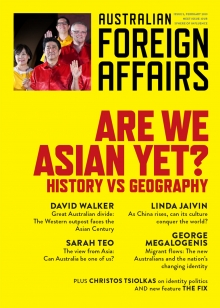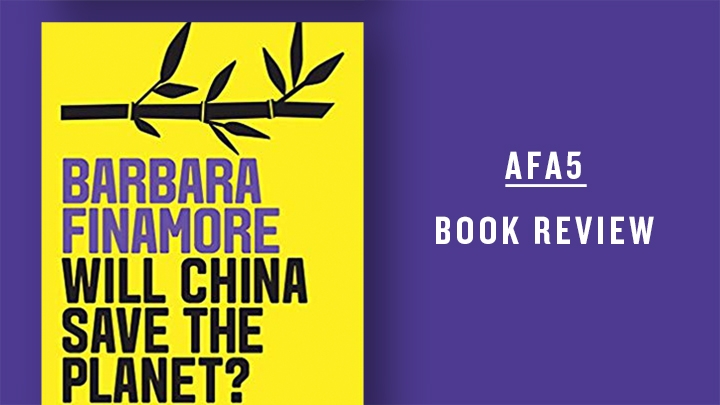
This review is featured in Australian Foreign Affairs 5: Are We Asian Yet?.
To read the full issue, log in, subscribe or buy the issue.
Will China Save the Planet?
Barbara Finamore
Polity Press
China’s breakneck growth, first unleashed during the 1980s, was once synonymous with environmental unsustainability. As Barbara Finamore writes in Will China Save the Planet?, a government accounting exercise found that widespread pollution of China’s air, water and soil caused losses of over US$80 billion in 2004, equivalent to about 3 per cent of China’s GDP that year.
China is also the world’s largest greenhouse-gas emitter by volume, and its environmental reputation hit an infamous low point in late 2009, when the country was widely blamed for the collapse of UN-led climate talks in Copenhagen.
Yet since then, China’s star has risen markedly. At the Paris conference in late 2015, nearly 200 countries signed a historic agreement to limit the global average temperature rise to well below 2 degrees Celsius. As Finamore rightly points out, China was “widely credited with playing a constructive role in reaching” the agreement, particularly through the unprecedented joint announcement of emissions curbs the previous year by Chinese president Xi Jinping and his then counterpart, US president Barack Obama.
Following the 2016 election of Donald Trump – who has dismantled environmental regulation in the United States, committed to withdraw from Paris and, preposterously, even called climate change a Chinese hoax – President Xi has only doubled down on his support for the UN accord and a low-carbon transition. At the 19th Congress of the Chinese Communist Party in October 2017, President Xi said that China was in the “driving seat” when it comes to “international cooperation” on climate change.
So is China really stepping up to a position of global leadership on climate? Finamore’s answer, in this concise and accessible volume, seems a cautious yes.
Yet while the credit for this, in Finamore’s book and elsewhere, has largely gone to China’s leaders, much should also be attributed to the role of ordinary people, entrepreneurs and grassroots environmental activists, whose freedom of action has often been severely constrained.
The author correctly identifies self-interest at the heart of China’s turnaround, pointing not only to the Chinese government’s concerns about the country’s climate-change vulnerabilities, but also to its drive to curb air pollution, to mollify mounting domestic concern about environmental degradation, to burnish its soft power and to lead in clean energy – the “largest new market opportunity of the twenty-first century”. This means, of course, dethroning “King Coal”, and Finamore, an environmental lawyer and campaigner with decades of experience in China, doesn’t make light of the challenge. Coal’s share in power generation in China may have dropped from 80 per cent in 2010 to 60 per cent in 2017, but it’s still a tough dependence to break – and, like anywhere else, there is also the pushback from “those who benefit from smokestack industries or stand to lose under the ‘new normal’: displaced workers, local governments, and the coal industry itself”. Still, Finamore makes a convincing case that the sheer dynamism of the renewable energy industry will win out. In 2017 alone, she notes, China installed more solar capacity than the total, cumulative solar capacity of any other country as of the end of 2016 – or enough photovoltaic panels to cover a soccer field every hour. The scale of Chinese manufacturing, meanwhile, has had a global effect, driving down solar prices “faster than anyone had ever imagined”.
The book also discusses innovation in the wind power and green buildings industries, but its profile of China’s electric vehicle industry – an important sector to examine, given the government’s ambition to compete globally in the electric car market – overlooks an important player in the nation’s energy transformation: its people. Finamore’s top-down narrative, which serves to valorise the state-led, centrally managed transition in China, rightly draws attention to the government’s decision to single out electric vehicles as a strategic priority. But a combination of factors, including the challenge of scaling charging infrastructure and grid integration, has proven difficult and helped to stifle consumer demand for EVs. Meanwhile, the humble electric bicycle – a demand-led, street-level game-changer – has become ubiquitous in Chinese cities, despite being actively discouraged by government policy (many cities still ban them). Overlooked in this volume, as it is by Chinese policymakers, the e-bike is cheap to purchase, doesn’t need expensive charging infrastructure, helps to solve urban air pollution – and, crucially, illustrates the ways that China’s bottom-up innovation and entrepreneurship, which it has in spades, can be unleashed to address environmental and social problems.
Moreover, exploring the role of China’s grassroots efforts would draw attention to a darker side of its changing political context, which receives short shrift in the text. Finamore notes that environmental enforcement in China was improved in 2015 through amendments to its Environmental Protection Law, which gave NGOs the ability to bring legal action against polluters. But she overlooks new laws restricting civil society, including 2017 legislation that put foreign groups under the supervision of the security services – and has sent an icy chill through the NGO sector.
Grassroots environmentalism flourished in China over the last decade, with the formation of hundreds of thousands of registered groups, and many more operating unregistered. Chinese civil society recorded several victories in opposing environmentally damaging projects, such as large dams and proposed petrochemical plants. But the past five years has seen steadily tightening controls on information, universities and think tanks, and severe restrictions on access to justice. This is critical, not only given the continued environmental challenges at home, but also the urgency of curbing China’s overseas investments in polluting sectors. Through President Xi’s signature overseas investment plan, the Belt and Road Initiative (BRI), surplus capital and technology is likely to continue to flow from industries such as coal, steel and cement, where production is slowing in China, into emerging economies.
Finamore does discuss the need to improve the environmental sustainability standards of China’s overseas investments – and rightly flags the stalwart efforts of green-leaning reformers in the banking system. But with much investment proposed for new coal-generation capacity overseas, the BRI already stands to lock in high carbon growth, presenting a critical challenge for the two-degree target under the Paris Agreement.
The question posed by the title, therefore, is salient – and the opportunities afforded by China’s expansion into the clean energy sector are potentially huge – but realities on the ground warrant a tempering of Finamore’s optimism, both over China, as civil society faces a clampdown, and overseas, as the country’s environmental footprint expands rapidly.
Sam Geall







